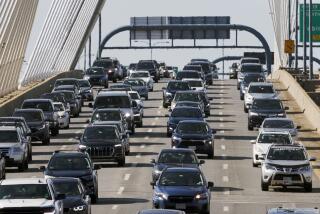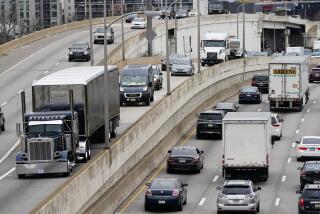An unlikely duo’s auto safety quest
- Share via
Four children were dead on an Oklahoma highway.
It was a crash scene so horrific that Jim Hall, chairman of the National Transportation Safety Board, flew down from Washington to oversee the investigation.
He spotted one of his engineers fiddling with some computer chips. “I asked him what he was doing,” Hall recalled. “And he told me he was trying to download some data, that he had found a black box.”
Until that day in 1994, Hall had not known that automakers were quietly installing black boxes, also known as event data recorders or EDRs, and encrypting the data.
Tom Kowalick, a North Carolina community college professor who taught the history of the Holocaust, made his own chance discovery of the devices several years later. Unlike Hall, he had no expertise, but was obsessed with the mysterious traffic death of his father in 1982.
Hall and Kowalick had almost nothing in common, except for being Army veterans. Kowalick liked to jump out of airplanes as a hobby; Hall vowed he “would never jump out of a good airplane.”
They became unlikely partners in 2001 in an audacious effort to push the worldwide automobile industry to begin installing standardized black boxes in every new car — a system they thought could revolutionize auto safety the way it had with aviation.
“The way to leapfrog safety is to copy the model from aviation,” Hall said. “Most of the major air safety improvements have come as a result of information from recorders.”
But their quest has led into a thicket of legal, constitutional and economic issues. They encountered arguments about who would own the data, its impact on defect lawsuits, whether computers would incriminate drivers, the cost effect on manufacturers and patent rights over the design of the systems.
Nearly a decade later, they are still at it.
The men met by chance in Washington. By the late 1990s, black boxes were no longer a secret. Kowalick was serving on a federal advisory committee studying the devices and had begun writing the first of seven books on the topic. At a government conference where Kowalick had a display, Hall wandered by and struck up a conversation with him. The two agreed to stay in touch.
Kowalick had tried to interest the government, technical organizations and the auto industry in his ideas, but got nowhere. On a hunch, he went to Greece, where the international electronics group IEEE was meeting. He cornered the group’s chairman and asked him to form a committee to develop black box standards.
“He told me I was pushing on an open door,” Kowalick recalled.
In a move that took the auto industry by surprise in 2001, Kowalick and Hall became co-chairmen of an IEEE committee and began pushing for a wide-ranging EDR standard — a departure from the norm of industry engineers calling the shots.
The duo were an odd match for the auto industry. Kowalick, 62, is intense, nervous and driven. He has forgotten to wear socks to meetings because he becomes so charged up.
He walks into interviews with a handcart piled 5 feet high with documents and computer hard drives. A former Army paratrooper who has made 3,000 jumps, he never shies away from a fight.
Hall, 68, readily acknowledges that Kowalick brought intensity and energy to the effort. An attorney and lifelong political practitioner, Hall worked for a series of courtly Southern senators and is skilled in the art of persuasion. Perfectly groomed, he would never forget his socks.
Their crusade left the auto industry miffed. After nearly a dozen committee meetings, representatives from General Motors, Toyota and Chrysler abruptly left. One major auto industry consultant complained the process was “dysfunctional.”
The pushback did not surprise Hall, a Vietnam War veteran who earned a Bronze Star.
“You know where the industry was coming from,” Hall said. “Toyota was the best example of how the industry wanted to control the information. Wouldn’t everybody like to control the information about their own mistakes?”
Toyota was among the most aggressive automakers in claiming control of the encrypted EDR data in its vehicles, and refused to provide downloads to its customers. After catching national attention last year for sudden acceleration problems, the company agreed to provide 10 EDR readers to federal officials. But the tools are not yet available to accident investigators across the country.
Hall and Kowalick did succeed in publishing a 171-page standard under IEEE sponsorship in 2005 that described how automakers should design an EDR. An update was approved in 2010.
Under their standard, automakers would record 86 different streams of data — including whether a motorist was using a turn signal before a crash, and the acceleration forces in every direction that affect a vehicle in a rollover.
It was the kind of system that proponents had long hoped would disclose whether driver errors, vehicle defects or highway design flaws were causing crashes. It would not be as sophisticated as an airliner black box, but would be far more capable than what the industry currently puts into vehicles.
“It could have been revolutionary,” said Ricardo Martinez, a National Highway Traffic Safety Administration chief in the 1990s. “These new vehicles are pulsing with data, and you are talking about a very small amount of it that can dramatically improve safety.”
But the standard is not binding, and no automakers are believed to have adopted it.
Wade Newton, a spokesman for the Alliance of Automobile Manufacturers, said the industry was not opposed to EDRs that record more information, but said they could take time to develop.
In response to Hall and Kowalick, automakers developed their own standard under the authority of the Society of Automotive Engineers. It aimed mainly at standardizing existing practices.
“Everybody in the industry buys into how valuable more information about crashes can be,” said Brian Everest, a General Motors manager who chairs the engineers society’s committee for EDRs. But, he added, “They really haven’t been around that long.”
In 2006, the NHTSA issued its own regulation for EDRs that would take effect in 2012. It did not require automakers to install the devices; if an automaker voluntarily puts one in a vehicle, it would have to record only 15 data elements, not the 86 envisioned by Hall and Kowalick.
When the NHTSA issued its final regulation, it estimated the cost at 50 cents per vehicle. Even then, the industry asked to delay the regulation, a request that is pending.
The NHTSA is now considering requiring automakers to install EDRs. The change came in the wake of its reliance on EDR data in investigating the sudden acceleration problems in Toyota vehicles.
Hall calls the whole process a textbook study in how to paralyze an idea.
“It has been tied down in the bureaucracy of Washington, D.C.,” Hall said recently.
Though he has left his formal role in the IEEE, Hall still advocates for EDRs and has pushed for federal legislation that would strengthen future requirements.
For Kowalick, the issue remains a central mission in his life, perhaps second only to skydiving.
“I am still obsessed by it,” he said recently. “Everything I do, I finish. I want to see this finished.”







